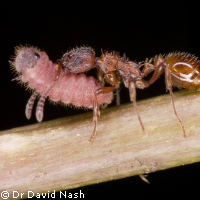Study observes co-evolutionary arms race between caterpillar and ants
Danish and British researchers have shed light on the fundamentals of evolutionary biology by studying the parasitic relationship between the larvae of the Alcon Large Blue Butterfly and two ant species in Denmark. In an article published in the current issue of Science, they reveal that the parasitism leads to a co-evolutionary arms race between the caterpillar and one of the ant species. The study was partly funded by the EU. 'There have been some previous studies on microscopic organisms showing that this can occur in the laboratory,' said biologist Dr David Nash of the University of Copenhagen, one of the scientists involved in the study, in a Science interview. 'But what we have here is one of the first cases where we have clear evidence that this has been happening out in the field.' The caterpillars, which initially live on a food plant and drop to the ground only at a later stage to be found by the ants, mimic the surface chemistry of the brood of Myrmica rubra and Myrmica ruginodis ants, thus 'producing a signal that says 'I'm an ant brood',' Dr Nash explained. As a result, the ants will mistake them for their own larvae and take them into the nest - the greater the degree of mimicry, the faster they get into the ants' nest. Once there, the caterpillars will feed on the ant brood and also be fed by the ants themselves, while they let their own brood starve. 'It has been suggested they [the caterpillars] might provide a kind of super-stimulus as well, though we still need to look into that further,' Dr Nash pointed out. The co-evolutionary process, however, in which parasitism would cause arbitrary changes in the makeup of the ant brood's surface chemicals, which in turn would be matched by the caterpillars, and so on, was only observed in one ant species, Myrmica rubra. This species 'tends to reproduce by budding, which means that neighbouring colonies tend to be very highly related to each other,' Dr Nash said. So, there is much greater possibility for local adaptation within the ants. According to the scientists, this species also tends to be exploited at a highly variable rate. 'A lot of this variation in parasitism is related to how common the ant is locally and that probably is also fed back from the effect of the caterpillars,' Dr Nash pointed out. 'This is something we have not demonstrated yet, but we think in some areas the butterfly can actually suppress that ant colony so much that it becomes very rare and is no longer worth exploiting for the butterfly and then it tends to use the other ant species as a refuge while that other species recovers.' This other species, Myrmica ruginodis, which shows a fairly constant rate of parasitic exploitation, has panmitic populations, meaning that there is a great degree of gene flow over relatively large distances from ant populations that are not infected by the parasite. Hence, the question of whether or not the ant species reacts to the parasite is one of social structure, the researchers concluded. The research, which was looking for suitable conservation measures for the Alcon Large Blue Butterfly in Denmark, was supported by the EU through a Marie Curie fellowship awarded to Dr Nash and the Fifth Framework Programme 'MacMan' project on Maculinea butterflies, as well as by several other national funding programmes.
Countries
Denmark, United Kingdom



